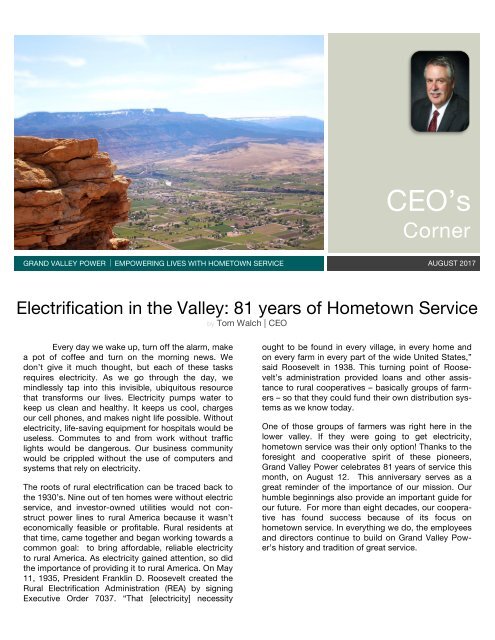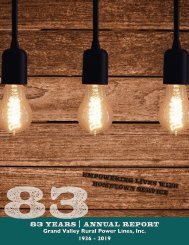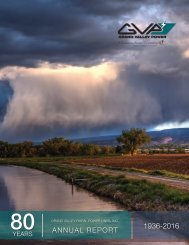Aug 2017_CEO newsletter
Create successful ePaper yourself
Turn your PDF publications into a flip-book with our unique Google optimized e-Paper software.
<strong>CEO</strong>’s<br />
Corner<br />
GRAND VALLEY POWER ú EMPOWERING LIVES WITH HOMETOWN SERVICE AUGUST <strong>2017</strong><br />
Electrification in the Valley: 81 years of Hometown Service<br />
by Tom Walch | <strong>CEO</strong><br />
Every day we wake up, turn off the alarm, make<br />
a pot of coffee and turn on the morning news. We<br />
don’t give it much thought, but each of these tasks<br />
requires electricity. As we go through the day, we<br />
mindlessly tap into this invisible, ubiquitous resource<br />
that transforms our lives. Electricity pumps water to<br />
keep us clean and healthy. It keeps us cool, charges<br />
our cell phones, and makes night life possible. Without<br />
electricity, life-saving equipment for hospitals would be<br />
useless. Commutes to and from work without traffic<br />
lights would be dangerous. Our business community<br />
would be crippled without the use of computers and<br />
systems that rely on electricity.<br />
The roots of rural electrification can be traced back to<br />
the 1930’s. Nine out of ten homes were without electric<br />
service, and investor-owned utilities would not construct<br />
power lines to rural America because it wasn’t<br />
economically feasible or profitable. Rural residents at<br />
that time, came together and began working towards a<br />
common goal: to bring affordable, reliable electricity<br />
to rural America. As electricity gained attention, so did<br />
the importance of providing it to rural America. On May<br />
11, 1935, President Franklin D. Roosevelt created the<br />
Rural Electrification Administration (REA) by signing<br />
Executive Order 7037. “That [electricity] necessity<br />
ought to be found in every village, in every home and<br />
on every farm in every part of the wide United States,”<br />
said Roosevelt in 1938. This turning point of Roosevelt’s<br />
administration provided loans and other assistance<br />
to rural cooperatives – basically groups of farmers<br />
– so that they could fund their own distribution systems<br />
as we know today.<br />
One of those groups of farmers was right here in the<br />
lower valley. If they were going to get electricity,<br />
hometown service was their only option! Thanks to the<br />
foresight and cooperative spirit of these pioneers,<br />
Grand Valley Power celebrates 81 years of service this<br />
month, on <strong>Aug</strong>ust 12. This anniversary serves as a<br />
great reminder of the importance of our mission. Our<br />
humble beginnings also provide an important guide for<br />
our future. For more than eight decades, our cooperative<br />
has found success because of its focus on<br />
hometown service. In everything we do, the employees<br />
and directors continue to build on Grand Valley Power’s<br />
history and tradition of great service.
The Glade Park Movies Under the Stars<br />
is back for the summer! The fundraiser<br />
supports the Glade Park Fire Department,<br />
and contributes up to 50 percent<br />
of the annual revenue. There are three<br />
showings during the month of <strong>Aug</strong>ust.<br />
• 8/4 - Fantastic Beasts and<br />
Where to Find Them (PG-13)<br />
• 8/11 - Finding Dori (PG)<br />
•<br />
• 8/18 - Dr Strange (PG-13)<br />
The grill opens at 6pm and serves up<br />
burgers, hot dogs and Polish sausage,<br />
while the concession stand sells<br />
all the goodies to round out a perfect moviewatching<br />
meal. Live entertainment begins at 7pm and the<br />
movie starts at dusk. Bring blankets and chairs, and enjoy the show.<br />
Check out the full schedule online and more details at the Glade Park Movies Under the Stars Facebook page.<br />
LOCATION: GLADE PARK VOLUNTEER FIRE DEPARTMENT, 16400 DS ROAD
Knowledge Center<br />
PowerOutage ENG.qxd:Layout 1 5/21/09 5:06 PM Page 1<br />
Be RedCrossReady<br />
Sudden power outages can be<br />
frustrating and troublesome, especially<br />
when they last a long time. If a power<br />
outage is 2 hours or less, you need not<br />
be concerned about losing your<br />
perishable foods. For prolonged power<br />
outages, though, there are steps you can<br />
take to minimize food loss and to keep<br />
all members of your household as<br />
comfortable as possible.<br />
Power Outage Checklist<br />
Energy Conservation Recommendations<br />
❏ Turn off lights and computers when not in use.<br />
❏ Wash clothes in cold water if possible; wash only full loads and clean the dryer's lint<br />
trap after each use.<br />
❏ When using a dishwasher, wash full loads and use the light cycle. If possible,<br />
use the rinse only cycle and turn off the high temperature rinse option. When<br />
the regular wash cycle is done, just open the dishwasher door to allow the dishes<br />
to air dry.<br />
❏ Replace incandescent light bulbs with energy-efficient compact fluorescent lights.<br />
How do I prepare for a<br />
power outage?<br />
What should I do during a<br />
power outage?<br />
What should I do when the power<br />
comes back on?<br />
To help preserve your food, keep the<br />
following supplies in your home:<br />
❏ One or more coolers—Inexpensive<br />
Styrofoam coolers work well.<br />
❏ Ice—Surrounding your food with ice in a<br />
cooler or in the refrigerator will keep food<br />
colder for a longer period of time during a<br />
prolonged power outage.<br />
❏ A digital quick-response thermometer—<br />
With these thermometers you can quickly<br />
check the internal temperatures of food to<br />
ensure they are cold enough to use safely.<br />
Put together an emergency<br />
preparedness kit with these supplies<br />
in case of a prolonged or widespread<br />
power outage:<br />
• Water—one gallon per person, per day (3-<br />
day supply for evacuation, 2-week supply for<br />
home) • Food—non-perishable, easy-toprepare<br />
items (3-day supply for evacuation,<br />
2-week supply for home) • Flashlight<br />
(NOTE: Do not use candles during a power<br />
outage due to the extreme risk of fire.) •<br />
Battery-powered or hand-crank radio (NOAA<br />
Weather Radio, if possible) • Extra batteries<br />
• First aid kit • Medications (7-day supply)<br />
and medical items • Multi-purpose tool •<br />
Sanitation and personal hygiene items •<br />
Copies of personal documents (medication<br />
list and pertinent medical information,<br />
deed/lease to home, birth certificates,<br />
insurance policies) • Cell phone with<br />
chargers • Family and emergency contact<br />
information • Extra cash<br />
❏ If someone in your home is dependent on<br />
electric-powered, life-sustaining<br />
equipment, remember to include backup<br />
power in your evacuation plan.<br />
❏ Keep a non-cordless telephone in your<br />
home. It is likely to work even when the<br />
power is out.<br />
❏ Keep your car’s gas tank full.<br />
Keep food as safe as possible.<br />
❏ Keep refrigerator and freezer doors closed<br />
as much as possible. First use perishable<br />
food from the refrigerator. An unopened<br />
refrigerator will keep foods cold for<br />
about 4 hours.<br />
❏ Then use food from the freezer. A full<br />
freezer will keep the temperature for about<br />
48 hours (24 hours if it is half full) if the<br />
door remains closed.<br />
❏ Use your non-perishable foods and<br />
staples after using food from the<br />
refrigerator and freezer.<br />
❏ If it looks like the power outage will<br />
continue beyond a day, prepare a cooler<br />
with ice for your freezer items.<br />
❏ Keep food in a dry, cool spot and keep it<br />
covered at all times.<br />
Electrical equipment<br />
❏ Turn off and unplug all unnecessary<br />
electrical equipment, including sensitive<br />
electronics.<br />
❏ Turn off or disconnect any appliances<br />
(like stoves), equipment or electronics you<br />
were using when the power went out.<br />
When power comes back on, surges or<br />
spikes can damage equipment.<br />
❏ Leave one light turned on so you’ll know<br />
when the power comes back on.<br />
❏ Eliminate unnecessary travel, especially<br />
by car. Traffic lights will be out and roads<br />
will be congested.<br />
Using generators safely<br />
❏ When using a portable generator, connect<br />
the equipment you want to power directly<br />
to the outlets on the generator. Do not<br />
connect a portable generator to a home’s<br />
electrical system.<br />
❏ If you are considering getting a generator,<br />
get advice from a professional, such as an<br />
electrician. Make sure that the generator<br />
you purchase is rated for the power that<br />
you think you will need.<br />
Let Your Family Know You’re Safe<br />
If your community experiences a disaster, register on the American Red Cross Safe and Well<br />
Web site available through RedCross.org to let your family and friends know about your<br />
welfare. If you don’t have Internet access, call 1-866-GET-INFO to register yourself and<br />
your family.<br />
❏ Do not touch any electrical power lines and<br />
keep your family away from them. Report<br />
downed power lines to the appropriate<br />
officials in your area.<br />
Throw out unsafe food.<br />
❏ Throw away any food that has been exposed<br />
to temperatures 40° F (4° C) for 2 hours or<br />
more or that has an unusual odor, color or<br />
texture. When in doubt, throw it out!<br />
❏ Never taste food or rely on appearance or<br />
odor to determine its safety. Some foods may<br />
look and smell fine, but if they have been at<br />
room temperature too long, bacteria causing<br />
food-borne illnesses can start growing<br />
quickly. Some types of bacteria produce<br />
toxins that cannot be destroyed by cooking.<br />
❏ If food in the freezer is colder than 40° F and<br />
has ice crystals on it, you can refreeze it.<br />
❏ If you are not sure food is cold enough, take<br />
its temperature with the food thermometer.<br />
Throw out any foods (meat, poultry, fish,<br />
eggs and leftovers) that have been exposed to<br />
temperatures higher than 40° F (4° C) for 2<br />
hours or more, and any food that has an<br />
unusual odor, color or texture, or feels warm<br />
to touch.<br />
Caution: Carbon Monoxide Kills<br />
❏ Never use a generator, grill, camp stove or<br />
other gasoline, propane, natural gas or<br />
charcoal-burning devices inside a home,<br />
garage, basement, crawlspace or any<br />
partially enclosed area. Locate unit away<br />
from doors, windows and vents that could<br />
allow carbon monoxide to come indoors.<br />
❏ The primary hazards to avoid when using<br />
alternate sources for electricity, heating or<br />
cooking are carbon monoxide poisoning,<br />
electric shock and fire.<br />
❏ Install carbon monoxide alarms in<br />
central locations on every level of your home<br />
and outside sleeping areas to provide early<br />
warning of accumulating carbon monoxide.<br />
❏ If the carbon monoxide alarm sounds,<br />
move quickly to a fresh air location<br />
outdoors or by an open window or door.<br />
❏ Call for help from the fresh air location and<br />
remain there until emergency personnel<br />
arrive to assist you.<br />
For more information on disaster and emergency preparedness, visit RedCross.org.<br />
Copyright © 2009 by the American National Red Cross | Stock No. 658564

















